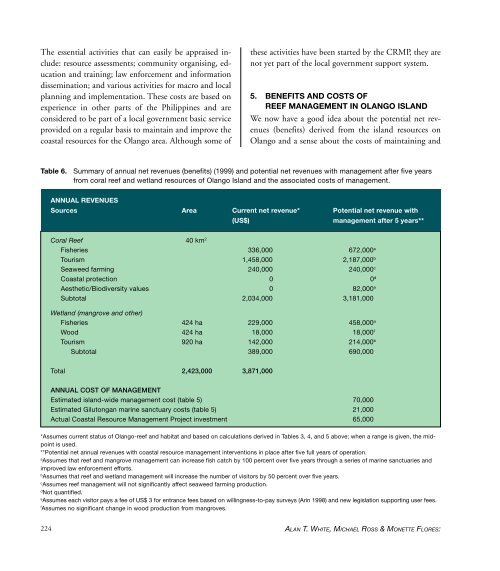Create successful ePaper yourself
Turn your PDF publications into a flip-book with our unique Google optimized e-Paper software.
The essential activities that can easily be appraised include:<br />
resource assessments; community organising, education<br />
and training; law enforcement and information<br />
dissemination; and various activities for macro and local<br />
planning and implementation. These costs are based on<br />
experience in other parts <strong>of</strong> the Philippines and are<br />
considered to be part <strong>of</strong> a local government basic service<br />
provided on a regular basis to maintain and improve the<br />
coastal resources for the Olango area. Although some <strong>of</strong><br />
these activities have been started by the CRMP, they are<br />
not yet part <strong>of</strong> the local government support system.<br />
5. BENEFITS AND COSTS OF<br />
REEF MANAGEMENT IN OLANGO ISLAND<br />
We now have a good idea about the potential net revenues<br />
(benefits) derived from the island resources on<br />
Olango and a sense about the costs <strong>of</strong> maintaining and<br />
Table 6.<br />
Summary <strong>of</strong> annual net revenues (benefits) (1999) and potential net revenues with management after five years<br />
from coral reef and wetland resources <strong>of</strong> Olango Island and the associated costs <strong>of</strong> management.<br />
ANNUAL REVENUES<br />
Sources Area Current net revenue* Potential net revenue with<br />
(US$)<br />
management after 5 years**<br />
<strong>Coral</strong> Reef 40 km 2<br />
Fisheries 336,000 672,000 a<br />
Tourism 1,458,000 2,187,000 b<br />
Seaweed farming 240,000 240,000 c<br />
Coastal protection 0 0 d<br />
Aesthetic/Biodiversity values 0 82,000 e<br />
Subtotal 2,034,000 3,181,000<br />
Wetland (mangrove and other)<br />
Fisheries 424 ha 229,000 458,000 a<br />
Wood 424 ha 18,000 18,000 f<br />
Tourism 920 ha 142,000 214,000 b<br />
Subtotal 389,000 690,000<br />
Total 2,423,000 3,871,000<br />
ANNUAL COST OF MANAGEMENT<br />
Estimated island-wide management cost (table 5) 70,000<br />
Estimated Gilutongan marine sanctuary costs (table 5) 21,000<br />
Actual Coastal Resource Management Project investment 65,000<br />
*Assumes current status <strong>of</strong> Olango-reef and habitat and based on calculations derived in Tables 3, 4, and 5 above; when a range is given, the midpoint<br />
is used.<br />
**Potential net annual revenues with coastal resource management interventions in place after five full years <strong>of</strong> operation.<br />
a<br />
Assumes that reef and mangrove management can increase fish catch by 100 percent over five years through a series <strong>of</strong> marine sanctuaries and<br />
improved law enforcement efforts.<br />
b<br />
Assumes that reef and wetland management will increase the number <strong>of</strong> visitors by 50 percent over five years.<br />
c<br />
Assumes reef management will not significantly affect seaweed farming production.<br />
d<br />
Not quantified.<br />
e<br />
Assumes each visitor pays a fee <strong>of</strong> US$ 3 for entrance fees based on willingness-to-pay surveys (Arin 1998) and new legislation supporting user fees.<br />
f<br />
Assumes no significant change in wood production from mangroves.<br />
224<br />
ALAN T. WHITE, MICHAEL ROSS & MONETTE FLORES:


















